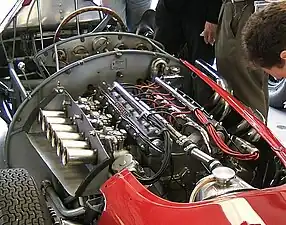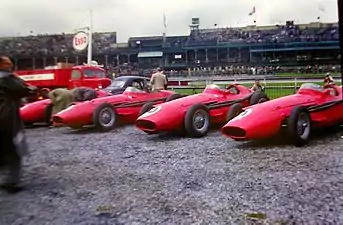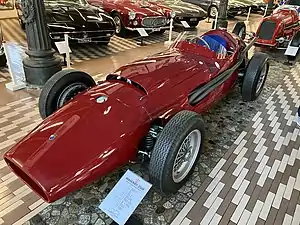_S%C3%BCdkehre.jpg.webp) | |||||||||
| Category | Formula One | ||||||||
|---|---|---|---|---|---|---|---|---|---|
| Constructor | Maserati | ||||||||
| Designer(s) | Gioacchino Colombo Valerio Colotti | ||||||||
| Production | 1954–1958 | ||||||||
| Predecessor | Maserati A6GCM | ||||||||
| Technical specifications | |||||||||
| Chassis | Aluminium tubular ladder frame | ||||||||
| Suspension (front) | Independent wishbone | ||||||||
| Suspension (rear) | De Dion tube | ||||||||
| Engine | Maserati 1954 – 2,493 cc (152.1 cu in), straight 6 1957 – 2,491 cc (152.0 cu in) works cars V12, naturally aspirated, All models:front engine, longitudinally mounted | ||||||||
| Transmission | 1954: Maserati 4 speed manual 1956: Stirnsi 5 speed manual | ||||||||
| Fuel | 50% methanol, 35% petrol, 10% acetone, 4% benzol, 1% castor oil | ||||||||
| Tyres | Pirelli | ||||||||
| Competition history | |||||||||
| Notable entrants | Officine Alfieri Maserati, Owen Racing Organisation, Equipe Moss/Stirling Moss Ltd | ||||||||
| Notable drivers | |||||||||
| Debut | 1954 Argentine Grand Prix, J.M. Fangio, 1st | ||||||||
| |||||||||
| Constructors' Championships | 0 (Note that the Constructors' Championship was first awarded in 1958) | ||||||||
| Drivers' Championships | 2 | ||||||||
| n.b. Unless otherwise stated, all data refer to Formula One World Championship Grands Prix only. | |||||||||

The Maserati 250F was a racing car made by Maserati of Italy used in '2.5 litre' Formula One racing between January 1954 and November 1960. Twenty-six examples were made.
Mechanical details
The 250F principally used the SSG, 220 bhp (at 7400rpm) 2,493 cc (152.1 cu in) capacity 84 mm × 75 mm (3.31 in × 2.95 in) Maserati A6 straight-six engine, ribbed 13.4" drum brakes, wishbone independent front suspension, a De Dion tube axle, Borrani 16" & 17" wheels and Pirelli Stella Bianca tyres. It was built by Gioacchino Colombo, Vittorio Bellentani and Alberto Massimino; the tubular work was by Valerio Colotti. A streamlined version with bodywork which partially enclosed the wheels (similar to the 1954 Mercedes-Benz W196 "Typ Monza") was used in the 1956 French Grand Prix.[1]
| Technical data | 250F | 250F T2 |
|---|---|---|
| Engine: | Front mounted 6-cylinder in-line engine | Front mounted 60° 12 cylinder V engine |
| displacement: | 2493 cc | 2491 cc |
| Bore x stroke: | 84 x 75 mm | 68.7 x 56 mm |
| Max power at rpm: | 270 hp (199 kW) at 8,000 rpm | 310 hp (228 kW) at 9,300 rpm |
| Valve control: | 2 overhead camshafts, 2 valves per cylinder | |
| Carburetor: | 3 Weber 45DCO3 | 6 Weber 35IDM |
| Gearbox: | 4/5-speed manual, transaxle | |
| suspension front: | Double wishbones, coil springs, hydraulic shock absorbers | |
| suspension rear: | De Dion axle, transverse leaf springs, hydraulic shock absorbers | |
| Brakes: | Hydraulic drum brakes | |
| Chassis & body: | Fackverk frame with aluminum body | steel tubular spaceframe |
| wheelbase: | 2,280 mm (90 in) | |
| Dry weight: | About 630 kg (1,400 lb) | About 650 kg (1,400 lb) |
| Top speed: | 290 km/h (180 mph) | 305 km/h (190 mph) |
Images
.JPG.webp) Maserati 250F
Maserati 250F straight 6 Maserati 250 F
straight 6 Maserati 250 F.JPG.webp) Cockpit
Cockpit Works team at Aintree, 1957
Works team at Aintree, 1957 Fangio and 250F
Fangio and 250F Maserati 250F v12 at the Umberto Panini museum
Maserati 250F v12 at the Umberto Panini museum
Racing history
The 250F first raced in the 1954 Argentine Grand Prix where Juan Manuel Fangio won the first of his two victories before he left for the new Mercedes-Benz team. Fangio won the 1954 Drivers' World Championship, with points gained with both Maserati and Mercedes-Benz; Stirling Moss raced his own privately owned 250F for the full 1954 season. Prince Bira was another driver favouring the 250F.
In 1955 a 5-speed gearbox; SU fuel injection (240 bhp) and Dunlop disc brakes were introduced. Jean Behra drove this in a five-member works team which included Luigi Musso.
In 1956 Stirling Moss won the Monaco and Italian Grands Prix, both in a works car.
In 1956 three 250F T2 cars first appeared for the works drivers. Developed by Giulio Alfieri using lighter steel tubes they sported a slimmer, stiffer body and sometimes the new 315 bhp (235 kW) V12 engine2,491 cc (152.0 cu in) capacity 68.7 mm × 56 mm (2.70 in × 2.20 in) , although it offered little or no real advantage over the older straight 6. It was later developed into the 3 litre V12 that won two races powering the Cooper T81 and T86 from 1966 to 1969, the final "Tipo 10" variant of the engine having three valves and two spark plugs per cylinder.
In 1957 Juan Manuel Fangio drove to four more championship victories, including his final win at German Grand Prix at the Nürburgring (Aug. 4, 1957), where he overcame a 48-second deficit in 22 laps, passing the race leader, Mike Hawthorn, on the final lap to take the win. In doing so he broke the lap record at the Nürburgring, 10 times.
By the 1958 season, the 250F was totally outclassed by the new rear engined F1 cars. However, the car remained a favourite with the privateers, including Maria Teresa de Filippis, and was used by back markers through the 1960 F1 season, the last for the 2.5 litre formula.
In total, the 250F competed in 46 Formula One championship races with 277 entries, leading to eight wins. Success was not limited to World Championship events with 250F drivers winning many non-championship races around the world.
Stirling Moss later said that the 250F was the best front-engined F1 car he drove.[2]
World Championship wins
Non-World Championship wins
References
Notes
- ↑ Grand Prix Data Book, David Hayhoe & David Holland, 2006
- ↑ bitsmartuk (13 May 2008). "Martin Brundle drives a Maserati 250f". Archived from the original on 2021-12-14. Retrieved 13 April 2018 – via YouTube.
Bibliography
- Hall, Andy (1990). Maserati 250F: A Technical Appraisal. Foulis motoring book series. Sparkford, Somerset, England; Newbury Park, CA, USA: Haynes Publishing. ISBN 0854298037.
- David McKinney, Maserati 250F,
External links
- 250F Overview Article Archived 2007-08-22 at the Wayback Machine
- Case history of 250F article with complete chassis data
- Top Gear 250F review